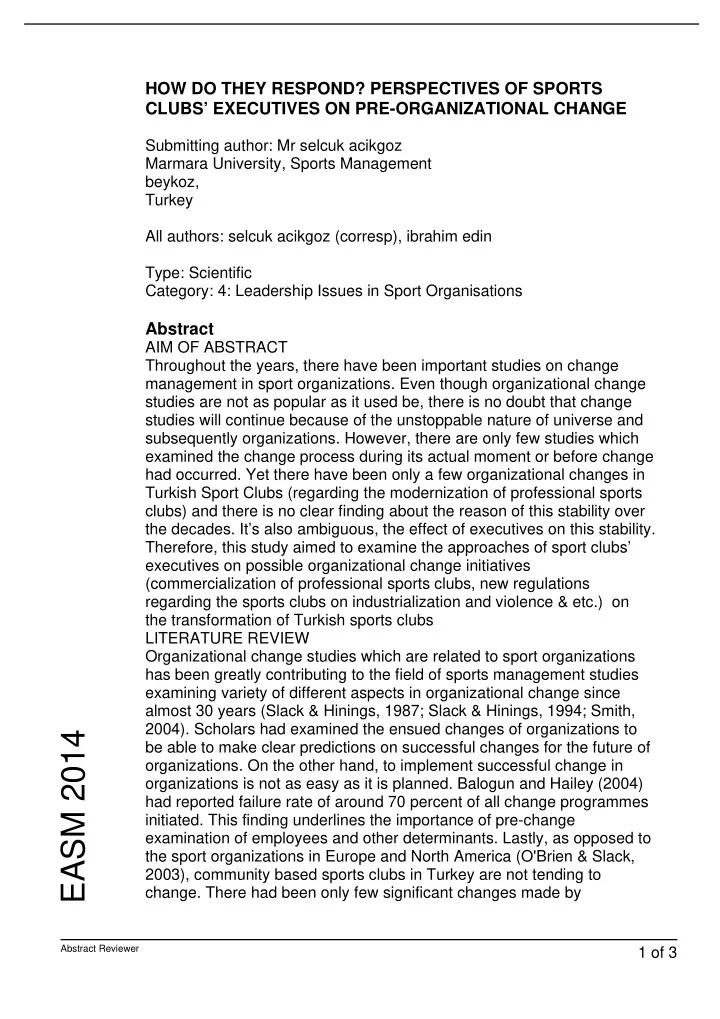

HOW DO THEY RESPOND? PERSPECTIVES OF SPORTS CLUBS’ EXECUTIVES ON PRE-ORGANIZATIONAL CHANGE Submitting author: Mr selcuk acikgoz Marmara University, Sports Management beykoz, Turkey All authors: selcuk acikgoz (corresp), ibrahim edin Type: Scientific Category: 4: Leadership Issues in Sport Organisations Abstract AIM OF ABSTRACT� Throughout the years, there have been important studies on change management in sport organizations. Even though organizational change studies are not as popular as it used be, there is no doubt that change studies will continue because of the unstoppable nature of universe and subsequently organizations. However, there are only few studies which examined the change process during its actual moment or before change had occurred. Yet there have been only a few organizational changes in Turkish Sport Clubs (regarding the modernization of professional sports clubs) and there is no clear finding about the reason of this stability over the decades. It’s also ambiguous, the effect of executives on this stability. Therefore, this study aimed to examine the approaches of sport clubs’ executives on possible organizational change initiatives (commercialization of professional sports clubs, new regulations regarding the sports clubs on industrialization and violence & etc.) on the transformation of Turkish sports clubs� LITERATURE REVIEW� Organizational change studies which are related to sport organizations has been greatly contributing to the field of sports management studies examining variety of different aspects in organizational change since almost 30 years (Slack & Hinings, 1987; Slack & Hinings, 1994; Smith, 2004). Scholars had examined the ensued changes of organizations to EASM 2014 be able to make clear predictions on successful changes for the future of organizations. On the other hand, to implement successful change in organizations is not as easy as it is planned. Balogun and Hailey (2004) had reported failure rate of around 70 percent of all change programmes initiated. This finding underlines the importance of pre-change examination of employees and other determinants. Lastly, as opposed to the sport organizations in Europe and North America (O'Brien & Slack, 2003), community based sports clubs in Turkey are not tending to change. There had been only few significant changes made by Abstract Reviewer 1 of 3
legislators since almost decades (Fişek, 1985). � METHODOLOGY, RESEARCH DESIGN AND DATA ANALYSIS� The research uses the qualitative data research techniques to examine perspectives of the executives on organizational change. The theory of institutional isomorphism (DiMaggio & Powell, 1983) had employed to see how executives react to change in the case of coercive isomorphism. Content and descriptive analyses are conducted after the in-depth interviews with 14 sports club executives from four different football league divisions. The interview questions are generated from organizational change studies (Coyle-Shapiro, 1999; Oreg, 2003; Demers, 2007; Tokat, 2012). The main idea was finding the most problematic points of organizational changes during process and turning them into logical questions for the interviews. The concepts that questions generated from were participation, change agent, communication, decision-making, reasons of change and radical vs. incremental change. These concepts turned into questions in a way to reveal the perspectives and attitudes of the executives on each factor. After the coding process, themes are generated, according to the comments of executives. After the data collection process, interviews transcribed verbatim and themes generated. Subsequently, descriptive analysis had been used to increase transparency and to be able to interpret statements, differently.� RESULTS, DISCUSSION AND CONCLUSIONS� Themes that generated according to the literature review are indicating that the executives don’t have bias towards communication, involvement and change agent except decision-making. They clearly stated that decision has to be taken by one or few people in the organization. This findings show that most of the implemented changes by managers refers to mimetic isomorphism. Another interesting finding is the statements of executives about other club executives or club presidents. Most of them has perceived some executives and presidents as an obstacle for the change and states that there need some regulation or change by legislators to clear out these people from clubs. Last important finding is the difference between professional executives of sport clubs and voluntary managers/executives of clubs. Professionals have perceived as more institutional oriented to change whereas volunteer managers and top executives experience-based. Supporting Fahlén’s (2008) study, findings also reveal that internal reactions in sports clubs are most crucial EASM 2014 part for successful organizational change. The results have illustrated that there is no direct resistance to change by executives. However, there are strong and also indirect conflicts between executives that might cause to failure of organizational changes. The main issue of sports clubs in Turkey doesn’t seem like the structure of clubs but undetailed and non-clarified characteristics of sports clubs and its some executives who are running clubs with personal desires that prevent clubs to become modernized and respected to the values and norms of sport itself. Abstract Reviewer 2 of 3
References REFERENCES� DiMaggio, P.J., & Powell, W.W. (1983). The iron cage revisited: Institutional isomorphism and collective rationality in organizational fields. American sociological review, 147-160.� Fahlén, J., Stenling, C., Vesting L. (2008). Money talks: a qualitative analysis of the organizational change connected with the corporation formation of a voluntary sport club. Sport und Gesellschaft–Sport and Society 5(2): 153-177.� Fişek, K. (1985). 100 Soruda Türkiye Spor Tarihi. İstanbul: Gerçek Yayınevi.� Oreg, S. (2006). Personality, context, and resistance to organizational change. European Journal of Work and Organizational Psychology, 15(1), 73-101.� Slack, T., & Hinings, B. (1992). Understanding Change in National Sport Organizations: An Integration of Theoretical Perspectives. Journal of sport management, 6(2). EASM 2014 Abstract Reviewer 3 of 3
Recommend
More recommend